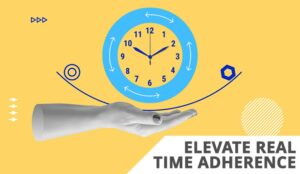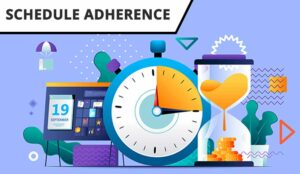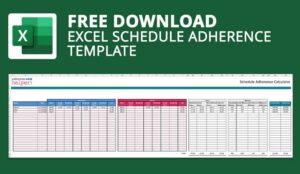Real-time adherence (RTA) allows managers to track agents’ adherence to their schedules in real time, so they can adjust as needed to meet service level goals.
But how can contact centre leaders be sure they’re taking the best approach? To find out, we asked our panel of experts for their best top tips, tools, and techniques they’ve seen in their combined decades of contact centre experience.
1. Use Positive Language When Discussing Non-Adherence With Agents
Contact centre managers must be very careful with their communication when it comes to real-time adherence.
It is easy for it to sound like surveillance when managers talk about having visibility of exactly when agents are off schedule and for what reason.
It is easy for it to sound like surveillance when managers talk about having visibility of exactly when agents are off schedule and for what reason.
There are several legitimate reasons why agents may not have adhered to schedule, and managers must use the right language when discussing non-adherence with agents. For example, instead of leading with “why are you not on schedule?”, ask “is everything okay?”
Wellbeing is a common factor when agents are not adhering to schedule, so it must be clear that monitoring RTA allows managers to support agents, not catch them out.
Contributed by: Scott Budding, Sales Engineering Manager, UK & EMEA, Calabrio
2. Fix the Underlying Causes of Non-Adherence

Fixing adherence problems means targeting the three biggest underlying causes and having rational conversations on an individual level.
Here are some insights on the different groupings agents can fall into, and some practical next steps on addressing them:
“Don’t Comply”
When an agent doesn’t comply, it can help to:
- Quantify the cost
- Demonstrate the impacts on the team
- Enhance the image of adherence as a personal and professional responsibility, as well as a team obligation. (Note, this will only work if there are no other blockers.)
“Can’t Comply”
When an agent can’t comply:
- It typically all comes down to tools, training, and processes – or unrealistic expectations.
“Won’t Comply”
When an agent won’t comply:
- Start looking at the root causes of disengagement, dissatisfaction, and demotivation. For example, a lack of any of the following: autonomy, recognition, meaning, purpose, and personal development. It could also simply be sheer frustration and burnout.
Contributed by: Grace Dawson, Business Development Representative, Odigo
3. Build in Flexibility to Accommodate Unforeseen Circumstances
Build flexibility into schedules to accommodate unforeseen circumstances. This makes sure that agents can handle unexpected workload variations while adhering to their schedules.
You could also adopt a real-time adherence dashboard within your contact centre software. This visual representation allows managers to quickly identify deviations and take corrective actions.
Monitor the dashboard regularly to identify discrepancies between scheduled and actual activities. Address issues promptly to maintain optimal service levels.
Contributed by: Tatiana Polyakova, COO, MiaRec
4. Use Adherence Scores for a Quick Overview of How Big the Problem Is

An overview adherence score identifies how big the adherence problem is and whether there is an improving or declining trend.
This helps, as you need to be able to spot which agents are out of adherence and for how long, so you can quickly take action.
You also need to allow a period of grace before taking action once an employee goes out of adherence; you really don’t want agents to prematurely end customer conversations just to stay in adherence.
On the other hand, you may want to keep an eye on agents whose recent adherence performance has not been up to scratch, so the means to ‘pin’ individuals on the adherence screen is useful.
As well as real-time adherence monitoring, you need historical adherence reports, which are extremely useful for appraisals and 1-to-1s.
Contributed by: Chris Dealy, WFM Evangelist, injixo
5. Make Everyone More Aware of and Accountable for Results
When supervisors have clear visibility into agent desktop activities, they can make sure that agents are doing the work that they are scheduled to be doing.
Agents can also be assured that everyone on the team is being evaluated equitably and objectively, increasing trust across the organization.
That’s why having a robust performance management solution can drive real-time adherence. This type of AI solution provides a single view of truth, providing transparency into performance at all organizational levels to make everyone more aware of and accountable for results.
Contributed by: Liran Meir Frenkel, Senior Product Marketing Manager, WEM, NICE
6. Keep Conversations Under Control With Real-Time Alerts

With contact centre agents facing an increasing number of complex and difficult calls, it’s important to gather, analyse and act on information the moment it’s received – while interactions and conversations are still happening.
More organizations are considering the use of real-time analytics and guidance tools to help identify signals when a conversation may be heading in negative direction and provide immediate, in-the-moment support so agents can better steer those interactions.
For example, real-time alerts can notify an agent when they’ve forgotten to ask for or tell the caller vital information.
Contributed by: Frank Sherlock, VP of International, CallMiner
7. Track Improvement Efforts With Adherence Percentages

Use automated software systems that can continuously track and record agent performance metrics, such as adherence percentages, average handling times, and service levels. This data can be used for ongoing analysis and improvement efforts.
Then provide coaching and feedback to agents who consistently deviate from their schedules. Understand the reasons behind the deviations and work together on solutions.
Contributed by: Tatiana Polyakova, COO, MiaRec
8. Adjust Your Targets as New Trends Emerge

When it comes to setting targets, contact centre managers must be realistic. Most managers understand that no agent will adhere to the schedule 100%, but they struggle to know where to set the bar when creating targets. The truth is that there is no one answer.
Adherence will differ for each contact centre, depending on a range of factors, both external and internal. The key is to measure first and then set a target that has the potential to stretch agents without putting too much pressure on them, and to review the target at regular intervals, moving it accordingly.
This may take a few attempts to get right, but if contact centre managers communicate with their agents to explain what the change is and why it is being made, adherence targets can be successfully set and met.
WFM solutions now also provide additional adherence interfaces, allowing managers to analyse recent schedules and identify when and why agents were out of adherence.
This allows themes and trends to be spotted so that targets can be adjusted, or support and training can be provided where necessary.
Contributed by: Scott Budding, Sales Engineering Manager, UK & EMEA, Calabrio
9. Reduce Supervisor Workload With Instant Updates
Gamification can be used to engage agents and motivate them to improve their performance. Using an AI-powered performance management solution can help reduce supervisor workload, providing instant updates and visibility into agent scorecards.
Supervisors can use this tool to identify productivity gaps and devote more time to targeted coaching to help optimize operations.
Contributed by: Liran Meir Frenkel, Senior Product Marketing Manager, WEM, NICE
10. Take Another Look at Your Goal-Setting Framework
Consider the following goal-setting frameworks:
- SMART – Specific, Measurable, Achievable, Relevant, and Time-bound
- FAST – Frequent discussions, Ambitious scope, Specific milestones, and Transparency
- EAST – Easy, Attractive, Social, and Timely
These ensure agents know what’s expected and EAST in particular uses elements of psychology to make behaviour change and improvement more likely.
The right goal-setting strategy can be perfectly paired with gamification. This keeps goals front of mind and can be linked to training and professional development not just numerical targets.
Social recognition, game mechanics, and real-life rewards all create a positive feedback loop for adherence in a fair and transparent way.
Contributed by: Grace Dawson, Business Development Representative, Odigo
If you want to read more about scheduling, forecasting and adherence, read these articles next:
- 8 Ways to Improve Schedule Adherence
- Tips, Tools, and Techniques for Contact Centre Forecasting
- 10 Tips, Tools, and Techniques for Enhancing Intraday Management
For more great insights and advice from our panel of experts, read these articles next:
- 7 Ways Technology Can Help Exceed Service Level Targets
- 3 Quick-Fire Ways to Get the Most Out of Live Chat
- Expert Predictions: What Will 2024 Bring for Contact Centres?
- Emerging WFM Trends to Look Out For
Author: Robyn Coppell
Published On: 22nd Jan 2024 - Last modified: 23rd Jan 2024
Read more about - Technology, Adherence, Calabrio, CallMiner, Chris Dealy, Frank Sherlock, Grace Dawson, Liran Meir Frenkel, MiaRec, NICE, Odigo, Peopleware, Real-Time Management, Scheduling, Scott Budding, Tatiana Polyakova, Top Story









































